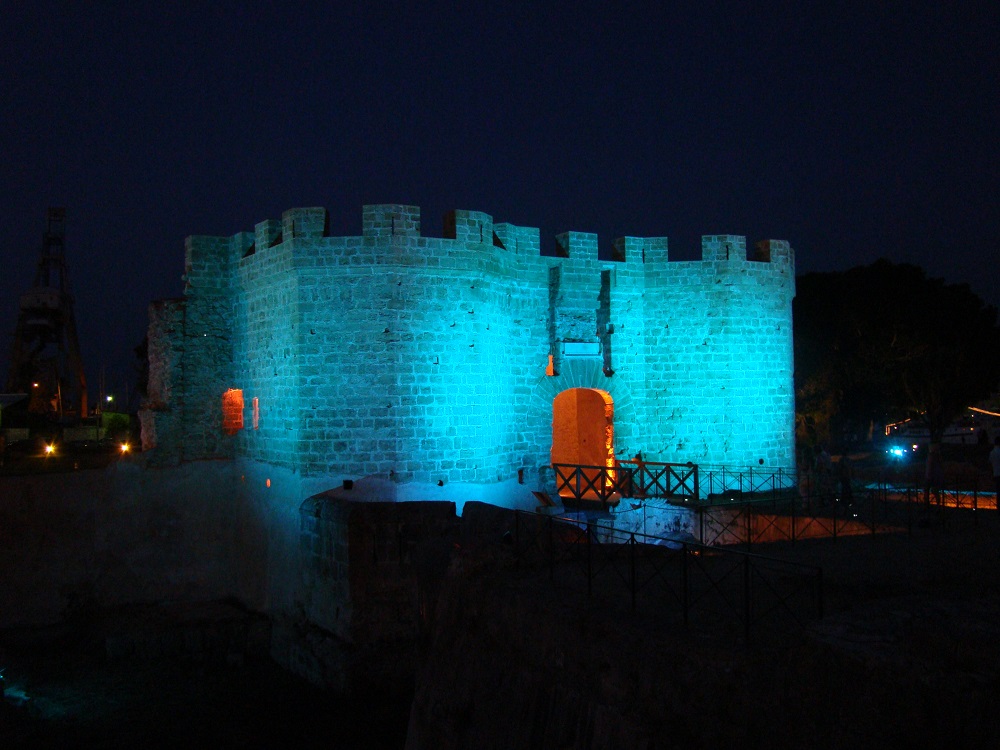Il castello a mare di Palermo è stato edificato, a partire dal X secolo, durante la dominazione musulmana, su un lembo di terra a nord dellimboccatura del porto della Qala. Alte mura perimetrali contornavano una grande piazza d’armi di forma trapezioidale e un mastio turriforme che si trovava al centro di tale vasta spianata interna. Il castello era poco lontano dal centro abitato cittadino e ne era separato da un grande spiazzo, dove era stata posta su di un basamento la statua di San Giovanni Nepomuceno.
In tutte le stampe e le foto depoca in cui si può ammirare il castello, risalta limmagine di una loggetta che si apriva sulla Cala e la sagoma della chiesa parrocchiale interna di San Silvestro.
Il castello a mare era stato potenziato in più occasioni ma raggiunse la sua maggiore potenza nel 1535, allorquando, dopo la visita a Palermo dellimperatore Carlo V, si ritenne necessario arricchirlo di ulteriori fortificazioni.
Nel castello abitò, per breve tempo, il Viceré (nel 1517) e in esso si trovavano le carceri per i nobili e i rei di lesa maestà, In esso morì, per uno scoppio di munizioni, il sommo poeta monrealese A. Veneziano, ivi carcerato. Essendo luogo di torture e di lacrime, fu sempre odiato dal popolo palermitano.
Durante le insurrezioni ottocentesche i borbonici usarono i cannoni sugli spalti del castello per sparare contro la popolazione inerme insorta, così dopo lingresso in città del liberatore Garibaldi, nel 1860, fu iniziato un lento smantellamento, mai del tutto completato. Recentemente, molti resti del castello sono stati portati alla luce e sono visitabili alcuni locali del torrione daccesso, è altresì, ancora visibile una parte del mastio arabo. Laccesso agli scavi avviene dalla Via Castello.
Indirizzo : (Ex Rione San Pietro )- Via Francesco Crispi – ingresso Via Filippo Patti. tel 0916116805
Visite: Lunedì chiusura; da Martedì a Sabato ore 9,00-16,30; Domeniche e Festivi: ore 9,00-13,30; N.B.:L’ultimo biglietto verrà staccato mezz’ora prima della chiusura. Ticket
The Castello a mare (Castle at Sea) of Palermo, on a strip of land on the north of the entrance of “Qala” port, had been built during the Muslim rule since the tenth century . High perimeter walls surrounded a large trapezoidal shaped square of weapons and a turreted tower that stood at the center of this vast interior space. The castle was not far from the inner city center and it was separated by a large open space, where the statue of “San Giovanni Nepomuceno had been placed on a pedestal. Among all prints and old photos in which you can admire the castle the image of a small balcony overlooking the Cala and the shape of the interior of the Parish Church of San Silvestro stand out.
The Castle at Sea had been upgraded on several occasions but reached its greatest power in 1535, when, after Emperor Charles V had visited Palermo, enriching it with additional fortifications was necessary.
The viceroy lived for a short time (in 1517) in the castle where there were the prisons for noblemen and for the guilty of treason (laesa maiestas). In this castle, for a burst of munitions, the great poet of Monreale A. Veneziano, imprisoned here, died. Being a place of torture and tears, the castle was always hated by the people of Palermo.
During the uprisings nineteenth century the Bourbons used the cannons on the ramparts of the castle to shoot the unarmed popular uprising, so after the entry into the city of “liberator” Garibaldi, in 1860, a slow dismantling started, never fully completed. Recently, many remains of the castle were brought to light and some parts to the access tower can be visited. It can also be visited a part of the Arab tower. Access to the excavations is in Via Castello.
Address: (Former District San Pietro) – Via Francesco Crispi – Entrance: Via Filippo Patti
Visits: Mon closed. Tue /Sat from 09:30am to 04:30 pm. Sun and Holidays from 9:00am to 01:30 pm. .
Ticket
Contacts: 0916391111 81015 – 81011

